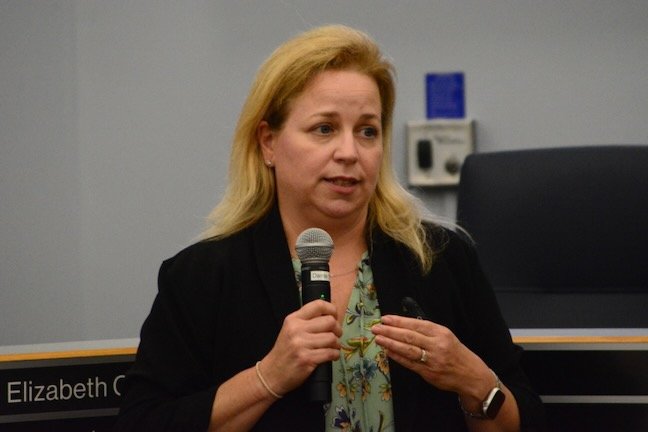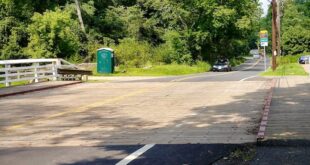
Somerset County officials on July 1 unveiled a $2 million project that is hoped will alleviate traffic congestion problems at the Griggstown Causeway.
If approved, the plan would not come into fruition for more than two years.
The project’s overriding goal is to increase safety on the bridge and the roads leading to it from River Road in Montgomery and Canal Road in Franklin.
Cars traveling in oncoming traffic to avoid queues of autos waiting to turn, cars approaching from opposite directions on the one-lane bridge, and oversized trucks using the Causeway were just some of the safety issues that officials hope will be mitigated by the project.
Debbie Hartman, a senior supervising engineer at WSP USA, the County’s engineering consultant, took a packed crowd in the County Commission’s meeting room through the planned project.
Traffic signals will be installed on each end of the bridge, she said, with only one lane at a time permitted to cross.
There will also be a left-turn lane installed on the bridge’s southbound side “because we know that that makes the intersection operate a little bit better,” she said.
A traffic signal will also be installed at the Causeway’s intersection with Canal Road, Hartman said.
“And those signals coordinate together, kind of disperse the traffic and meter the traffic through the whole area, instead of all the cars getting bunched up in one place, kind of spreads the love everywhere.” she said.
“The biggest advantage, obviously, it gives order to this intersection where there is no order currently,” Hartman said.
“It maintains your historic one-lane bridge and it reduces the overall intersection delay,” she said. “And then that southbound left turn lane allows, those left turns, gives a little bit more capacity there.”
There will also be three-way stop signs placed at the intersection of Canal Bunker Hill roads, she said.
Hartman said these improvements would drastically cut the number of cars queued on both sides of the bridge during morning and, especially, afternoon rush hours.
“We looked at a ton of different options,” she said. “We wanted to leave no stone unturned. We wanted to make sure that everybody was satisfied that what bubbled up, and the preliminary preferred alternative kind of is the best option.”
The idea of putting a traffic light at the Causeway intersection with Canal Road did not sit well with Township Councilmember Ed Potosnak. Potosnak attended the meeting with Mayor Phil Kramer, Township Manager Robert Vornlocker, and Planning Board member Ted Chase.
“I think that a historic characteristic would be diminished with a light there,” he said. “And I’m wondering what the safety implications are of removing that light and going to a three-way stop sign, like we’re anticipating at Bunker Hill and Canal. But if I lived on Canal Road … I wouldn’t want cars lining up there.”
“It actually makes a lot more sense to line up on the Griggstown Causeway Road, because that’s where people’s homes aren’t,” Potosnak said. “And so that’s the thing I walk away from this the most is, can we transfer that from a light to a stop sign?”
“We did look at it as a stop sign, and it actually negatively affected the operations even more on the River Road side,” Hartman said.
A suggestion by an audience member that Canal Road be widened brought Kramer to his feet.
“Canal is a local road, it is not a highway,” he said. “River Road is a highway, it was designed to be a highway. That’s why I don’t want a two-lane bridge, because that would bring more cars over to Canal Road.”
“But I don’t want to widen that road because we’ll get more cars on it,” he said. “I see the bikers on it, it scares the bejesus out of me. And people walking, it scares me too.”
Kramer said a wider road would also encourage drivers to go faster.
Vornlocker said that concept has “been proven through many, many studies over many, many years, that the wider the road, the higher the speed. That road has so many physical constraints that it really can’t be widened in that stretch from Griggstown Causeway to 518.”
Vornlocker supported the plan advanced by the County’s consultant.
“I believe, with all of my experience, that this is a good, solid solution to the problem from a safety standpoint,” he said. “You can look at options down the road for pedestrians and bicycles. That can be an add-on later.”
Hartman also went through some of the alternatives that were not chosen.
“The first one is do nothing,” she said. “It’s always what you have to kind of compare your baseline to, so you look at what happens if you do nothing.”
“Obviously, it doesn’t cost anything,” she said. “There’s no right-of-way impacts, but you haven’t improved safety at all, which is like the driving force for this project.”
“The second thing we looked at was changing the control of that intersection to just an all-way stop control,” she said. “It is cheap, doesn’t cost a whole lot, just really a sign or two. There are no right-of-way impacts. It does reduce the overall delay of the intersection, but it doesn’t really stop the competing traffic on the bridge because cars can still and will still go on the bridge when maybe it’s not their turn. So that was not chosen.”
The third option, Hartman said, was “what’s called an intersection conflict warning system. And what this does, it’s kind of like the baby step before you do a traffic signal, where you have a radar detection on each side, and you have a flashing warning sign that says traffic is entering, and you kind of rely on people’s free will to go or not go and to obey these signs. Some of the advantages of it, it’s not that expensive to put in.”
“It’s easy to install, however, there are questions about how you optimize it, how effective it is, because it really depends on people listening to the sign or not,” Hartman said. “But again, we didn’t really choose it because we weren’t sure if they would eliminate that competing traffic on the bridge if people really didn’t obey the indication.”
The next alternative, she said, “was leaving the bridge as it is and making that one of the directions, the westbound direction, and then putting a parallel new bridge right next to it that would be the eastbound direction. And one of the advantages of that is it does fix your safety issue, because now you’ve separated your two lanes of traffic.”
“It does improve your level of service, it reduces delay,” she said. “There are six partial property acquisitions that are related to it.”
The downside, Hartman said, is that there would be “extensive” permitting needed, “because now you’re impacting wetlands, and that process can be a long, drawn-out process with the NJDEP. And that was $5.4 million, so now you’re kind of starting to get a little bit more expensive. So it was not chosen because of the high cost.”
Another alternative not chosen, she said, was making the causeway and bridge one-way. The problem, she said, is that the nearest bridges for alternative routes are three miles away.
Kramer said after the meeting that he thought the preferred plan was good.
“I think it’s a giant step forward,” he said. “I have some questions about the stoplight on Canal Road.”
“Which is better, stoplight or three-way stop?” he said. “But I’m happy that this is going forward.”
Potosnak agreed.
“I’d like to see some modification at the intersection of Canal and Griggstown Causeway Road so that we don’t have a light blaring and the homeowners have backed up traffic along Canal Road,” he said. “I do want to take them at their word that they did the study and see what the implications of a three-way stop sign at that location would mean for traffic flows.”
“And then the second thing is keeping the historic nature of the Causeway Bridge as a one-lane road, given that it’s a newer bridge, just makes fiscal sense,” Potosnak said. “And it’s not going to be improving traffic flows in any sort of way by making it a two-lane bridge. Keeping the historic quality of it is a real win for our community and the historic nature of the area.”
Next steps in the project involve getting resolutions of support from the Montgomery and Franklin governments, followed by about two years of design and permitting, and then construction, which is expected to take six months.
Stay ‘In the Know,’ subscribe to the Franklin Reporter & Advocate!
No other media outlet covering Franklin Township brings you the depth of information presented by the Franklin Reporter & Advocate. Period. We are the only truly independent media serving the Eight Villages.
But we can only do that with your support. Please consider a yearly subscription to our online news site; at $37 a year, it’s one of the best investments you can make for yourself.
To subscribe, please click here.
 The Franklin Reporter & Advocate Eight Villages, One Community
The Franklin Reporter & Advocate Eight Villages, One Community

